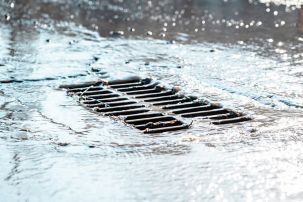Lesson summary
In this activity students work in groups to complete an audit of the school’s stormwater system. Students begin by looking at maps of the local area and making assessments about where stormwater from their school would go, in particular, which waterways would school stormwater enter into. Students then use a map of the school grounds to identify all the stormwater drains at their school, and make recommendations for improving the stormwater system that can be incorporated into the School Water Management Plan.
Learning intentions:
Students will...
- recognise the relationship between schoolyard waste and healthy waterways.
- identify strategies for improving school stormwater systems.
- use maps tounderstand the flow of stormwater at their school and in the local community.
Lesson guides and printables
Lesson details
Curriculum mapping
Australian Curriculum content descriptions:
- Some of Earth’s resources are renewable, including water that cycles through the environment, but others are non-renewable (ACSSU116)
Geography Year 7:
- The nature of water scarcity and ways of overcoming it, including studies drawn from Australia and West Asia and/or North Africa (ACHGK040)
- Collect, select and record relevant geographical data and information, using ethical protocols, from appropriate primary and secondary sources (ACHGS048)
- Present findings, arguments and ideas in a range of communication forms selected to suit a particular audience and purpose; using geographical terminology and digital technologies as appropriate (ACHGS053)
- Reflect on their learning to propose individual and collective action in response to a contemporary geographical challenge, taking account of environmental, economic and social considerations, and predict the expected outcomes of their proposal (ACHGS054)
Geography Year 8:
- Collect, select and record relevant geographical data and information, using ethical protocols, from appropriate primary and secondary sources (ACHGS056)
- Present findings, arguments and ideas in a range of communication forms selected to suit a particular audience and purpose, using geographical terminology and digital technologies as appropriate (ACHGS061)
- Reflect on their learning to propose individual and collective action in response to a contemporary geographical challenge, taking account of environmental, economic and social considerations, and predict the expected outcomes of their proposal (ACHGS062)
Geography Year 9:
- Collect, select, record and organise relevant geographical data and information, using ethical protocols, from a range of appropriate primary and secondary sources (ACHGS064)
- Present findings, arguments and explanations in a range of appropriate communication forms, selected for their effectiveness and to suit audience and purpose; using relevant geographical terminology, and digital technologies as appropriate (ACHGS070)
Geography Year 10:
- Collect, select, record and organise relevant data and geographical information, using ethical protocols, from a range of appropriate primary and secondary sources (ACHGS073)
- Present findings, arguments and explanations in a range of appropriate communication forms selected for their effectiveness and to suit audience and purpose, using relevant geographical terminology and digital technologies as appropriate (ACHGS079)
- Reflect on and evaluate the findings of the inquiry to propose individual and collective action in response to a contemporary geographical challenge, taking account of environmental, economic and social considerations; and explain the predicted outcomes and consequences of their proposal (ACHGS080)
Cross curriculum priorities:
Sustainability – OI.1 – The biosphere is a dynamic system providing conditions that sustain life on Earth. OI.5 – World views are formed by experiences at personal, local, national and global levels, and are linked to individual and community actions for sustainability.
OI.9 – Sustainable futures result from actions designed to preserve and/or restore the quality and uniqueness of environments.
General capabilities:
Numeracy, Critical and creative thinking
Syllabus Outcomes: GE4-1, GE4-2, GE4-3, GE4-4, GE4-5, GE4-7, GE4-8, GE5-7, GE5-8.
Connecting lessons: Water Use Audit – must be completed as a compulsory action.
Resources required
- Student worksheet
- Internet access
- Hard copy map of the local area (ask your local council or print from Google Maps – ideally this map will have contour lines), hard copy map of your school (your school map have one you can copy or print from Google Maps)
- Factsheet – Sewage or stormwater?
Additional info
This lesson can be used when working on the Water Module of ResourceSmart AuSSI Vic Certification. By completing this lesson you will have completed the following actions:
Compulsory Actions:
- A1.1 – Have you completed an audit to assess water usage and stormwater collection around your school?
- A1.2 Have you collected data on past water usage for at least two years?
- A1.3 Has this data been entered as your baseline data?
Checklist data goals:
- No official data goals.


Welcome back!
Don't have an account yet?
Log in with:
By signing up to Cool.org you consent and agree to Cool's privacy policy to
store, manage and process your personal information. To read more, please see
our privacy policy here(Opens in new tab).
Create your free Cool.org account.
Many of our resources are free, with an option to upgrade to Cool+ for premium content.
Already have an account?
Sign up with:
By signing up to Cool.org you consent and agree to Cool's privacy policy to
store, manage and process your personal information. To read more, please see
our privacy policy here(Opens in new tab).